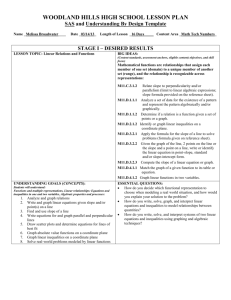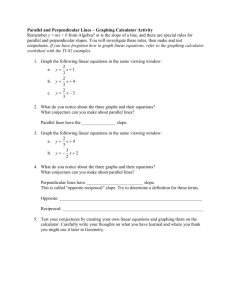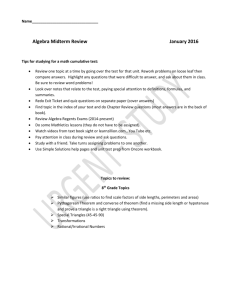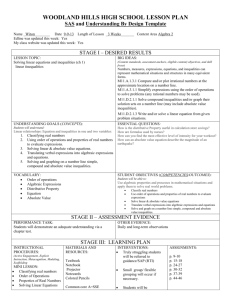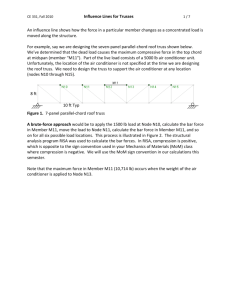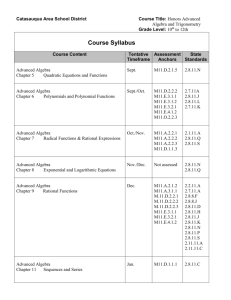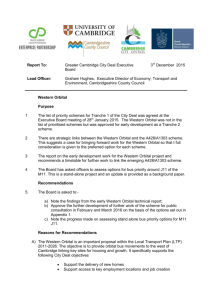Algebra II Chapter 2: Linear Equations and Functions
advertisement
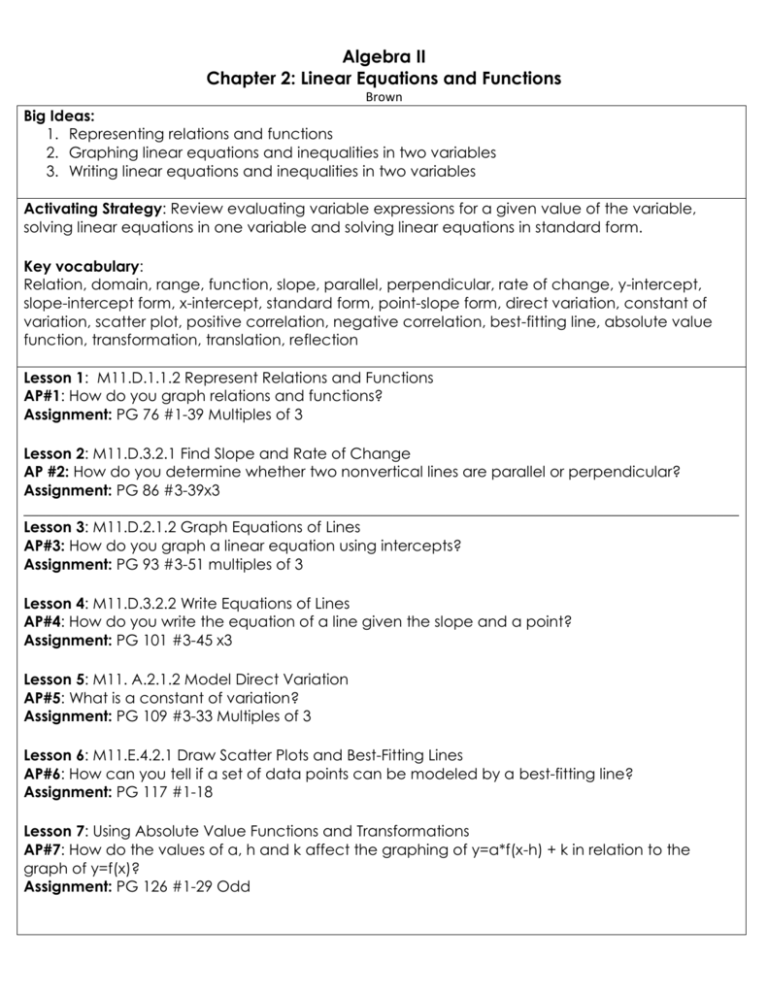
Algebra II Chapter 2: Linear Equations and Functions Brown Big Ideas: 1. Representing relations and functions 2. Graphing linear equations and inequalities in two variables 3. Writing linear equations and inequalities in two variables Activating Strategy: Review evaluating variable expressions for a given value of the variable, solving linear equations in one variable and solving linear equations in standard form. Key vocabulary: Relation, domain, range, function, slope, parallel, perpendicular, rate of change, y-intercept, slope-intercept form, x-intercept, standard form, point-slope form, direct variation, constant of variation, scatter plot, positive correlation, negative correlation, best-fitting line, absolute value function, transformation, translation, reflection Lesson 1: M11.D.1.1.2 Represent Relations and Functions AP#1: How do you graph relations and functions? Assignment: PG 76 #1-39 Multiples of 3 Lesson 2: M11.D.3.2.1 Find Slope and Rate of Change AP #2: How do you determine whether two nonvertical lines are parallel or perpendicular? Assignment: PG 86 #3-39x3 _______________________________________________________________________________________________ Lesson 3: M11.D.2.1.2 Graph Equations of Lines AP#3: How do you graph a linear equation using intercepts? Assignment: PG 93 #3-51 multiples of 3 Lesson 4: M11.D.3.2.2 Write Equations of Lines AP#4: How do you write the equation of a line given the slope and a point? Assignment: PG 101 #3-45 x3 Lesson 5: M11. A.2.1.2 Model Direct Variation AP#5: What is a constant of variation? Assignment: PG 109 #3-33 Multiples of 3 Lesson 6: M11.E.4.2.1 Draw Scatter Plots and Best-Fitting Lines AP#6: How can you tell if a set of data points can be modeled by a best-fitting line? Assignment: PG 117 #1-18 Lesson 7: Using Absolute Value Functions and Transformations AP#7: How do the values of a, h and k affect the graphing of y=a*f(x-h) + k in relation to the graph of y=f(x)? Assignment: PG 126 #1-29 Odd Algebra II Pacing Guide: Chapter 2 Lesson 8: M11.D.2.1.2 Graph Linear Inequalities in Two Variables AP#8: What does a dashed boundary line on the graph of an inequality represent? Assignment: PG 135 #1-29 Odd Extended Thinking Activity: PG 112 (Sec 2.6) Fitting a Line to Data Summarizing Strategy: Review main concepts pgs 140-144/ Review for exam: Practice Test Algebra II Pacing Guide: Chapter 2 Big Ideas: 1. Representing relations and functions 2. Graphing linear equations and inequalities in two variables 3. Writing linear equations and inequalities in two variables _______________________________________________________________________________________________ Key vocabulary: Relation, domain, range, function, slope, parallel, perpendicular, rate of change, y-intercept, slope-intercept form, x-intercept, standard form, point-slope form, direct variation, constant of variation, scatter plot, positive correlation, negative correlation, best-fitting line, absolute value function, transformation, translation, reflection Lesson 1: M11.D.1.1.2 Represent Relations and Functions AP#1: How do you graph relations and functions? Assignment: Lesson 2: M11.D.3.2.1 Find Slope and Rate of Change AP #2: How do you determine whether two nonvertical lines are parallel or perpendicular? Assignment: _______________________________________________________________________________________________ Lesson 3: M11.D.2.1.2 Graph Equations of Lines AP#3: How do you graph a linear equation using intercepts? Assignment: Lesson 4: M11.D.3.2.2 Write Equations of Lines AP#4: How do you write the equation of a line given the slope and a point? Assignment: Lesson 5: M11. A.2.1.2 Model Direct Variation AP#5: What is a constant of variation? Assignment: Algebra II Pacing Guide: Chapter 2 Lesson 6: M11.E.4.2.1 Draw Scatter Plots and Best-Fitting Lines AP#6: How can you tell if a set of data points can be modeled by a best-fitting line? Assignment: Lesson 7: Using Absolute Value Functions and Transformations AP#7: How do the values of a, h and k affect the graphing of y=a*f(x-h) + k in relation to the graph of y=f(x)? Assignment: Lesson 8: M11.D.2.1.2 Graph Linear Inequalities in Two Variables AP#8: What does a dashed boundary line on the graph of an inequality represent? Assignment:

